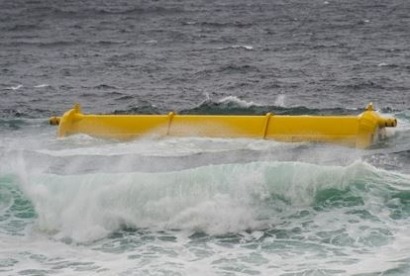
In making the announcement, at the All Energy conference in Aberdeen , Fergus Ewing, Scotland's Minister for Energy, Enterprise and Tourism, described the project as "an exciting, dynamic Scottish company that is increasingly expanding its renewable business.
"The development of up to 50 Oyster wave devices off the North West coast of Lewis, when operational, will have the power to produce 40MW of renewable electricity," Ewing said. "This is another significant milestone for Scotland's wave sector. With 10 per cent of Europe's wave power potential, and 25 per cent of its offshore wind and tidal power potential, the opportunities for Scotland are enormous."
The green light from the government and its regulator Marine Scotland, along with onshore planning which was approved last September, means the Edinburgh firm, through its wholly owned subsidiary Lewis Wave Power Limited, will be able to begin installing their near-shore Oyster wave energy machines at the site in the next few years - once the necessary grid infrastructure has been put in place.
This will ultimately see the deployment of between 40 and 50 Oyster devices along the coast at Lag na Greine, near to Fivepenny Borve, in one of the best wave energy locations in Europe.
Once complete, the farm will have the capacity to power nearly 30,000 homes, the company said.
In 2012 the local council, Comhairle nan Eilean Siar (Western Isles Council), approved planning for the onshore hydroelectric power plant which will be connected to the Oyster wave energy farm.
Aquamarine Power is currently testing their second full scale wave machine, known as the Oyster 800, at the European Marine Energy Centre (EMEC) in Orkney, and are now producing electrical power to the grid.
"This is a significant milestone for our company," said Aquamarine Power Chief Executive Officer Martin McAdam. "The goal of our industry is to become commercial, and to do this we need two things - reliable technologies and a route to market. Our engineers are currently working hard on getting the technology right and we now have a site where we can install our first small farm, with a larger-scale commercial build out in the years ahead.
"We have worked in close consultation with the people and businesses of Lewis in the development of our proposals and would like to express our gratitude for their ongoing support. We were delighted with the turnout at the series of public exhibitions we held on Lewis last March, and we also commend government regulator Marine Scotland and the Western Isles Council for their positive approach," McAdam continued. "We believe wave energy presents an important opportunity for the Isle of Lewis. Our development could provide significant economic benefit to the local community. In Orkney, for example, we have spent over £5 million in the local economy during the installation of the first two Oyster devices and have worked with over 40 local companies as part of our commitment to sourcing much of the services and expertise we require locally."
Niall Stuart, chief executive of Scottish Renewables, welcomed word of the government's consent, describing it as "further proof that we have become home to a world leading marine energy industry that is delivering jobs and investment to communities across Scotland.
"However, we can't forget that this is the kind of prize that could be lost unless costs for projects to connect to the grid on the islands are set at a competitive level," Stuart said.
"This announcement is a fantastic boost for Scotland's marine renewables sector and will put Lewis firmly on the world map when it comes to wave energy," said Lang Banks, director of WWF Scotland.
However, he added, if Scotland is to rule the waves when it comes to marine renewables then it's vital we quickly resolve the issues of grid connection and transmission costs to the Scottish islands.
"Alongside energy saving measures, wave power and other renewables have a critical role to play in helping Scotland reduce climate emissions, create jobs and generate export opportunities. With careful planning we can harness the waves and tides while safeguarding the nation's tremendous marine environment," Lang said.
For additional information:

